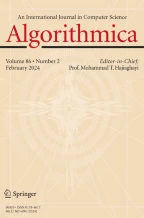Abstract
Given a textstringx of lengthn, theMinimal Augmented Suffix Tree T (x) ofx is a digital-search index that returns, for anyquery stringw and in a number of comparisons bounded by the length ofw, the maximum number of nonoverlapping occurrences ofw inx. It is shown that, denoting the length ofx byn, T(x) can be built in timeO(n log2 n) and spaceO(n logn), off-line on a RAM.
Similar content being viewed by others
References
A. V. Aho, J. E. Hopcroft, and J. D. Ullman,The Design and Analysis of Computer Algorithms, Addison-Wesley, Reading, MA, 1974.
A. Apostolico, The myriad virtues of subword trees, inCombinatorial Algorithms on Words (A. Apostolico and Z. Galil, eds.), ASI F-12, Springer-Verlag, New York, pp. 85–95, 1985.
A. Apostolico and F. P. Preparata, Optimal off-line detection of repetitions in a string,Theoret. Comput. Sci.,22 (1983), pp. 297–515.
A. Apostolico and F. P. Preparata, Structural properties of the string statistics problem,J. Comput. System Sci.,31(3) (1985), 394–411.
M. Crochemore and W. Rytter, Squares, cubes, and time-space efficient string searching,Algorithmica,13 (1995), 405–425.
R. C. Lyndon and M. P. Schutzenberger, The equationa M =b N c P in a free group,Michigan Math. J.,9 (1962), 289–298.
E. M. McCreight, A space economical suffix tree construction algorithm,J. Assoc. Comput. Mach.,25 (1976), 262–272.
Author information
Authors and Affiliations
Additional information
Communicated by C. K. Wong.
This research was supported in part, through the Leonardo Fibonacci Institute, by the Istituto Trentino di Cultura, Trento, Italy.
Additional support was provided by NSF Grants CCR-8900305 and CCR-9201078, by NATO Grant CRG 900293, by the National Research Council of Italy, and by the ESPRIT III Basic Research Programme of the EC under Contract No. 9072 (Project GEPPCOM).
Additional support was provided by NSF Grant CCR-91-96176 and ONR Contract N 00014-91-J-4052, ARPA Order 2225.
Rights and permissions
About this article
Cite this article
Apostolico, A., Preparata, F.P. Data structures and algorithms for the string statistics problem. Algorithmica 15, 481–494 (1996). https://doi.org/10.1007/BF01955046
Received:
Revised:
Issue Date:
DOI: https://doi.org/10.1007/BF01955046
